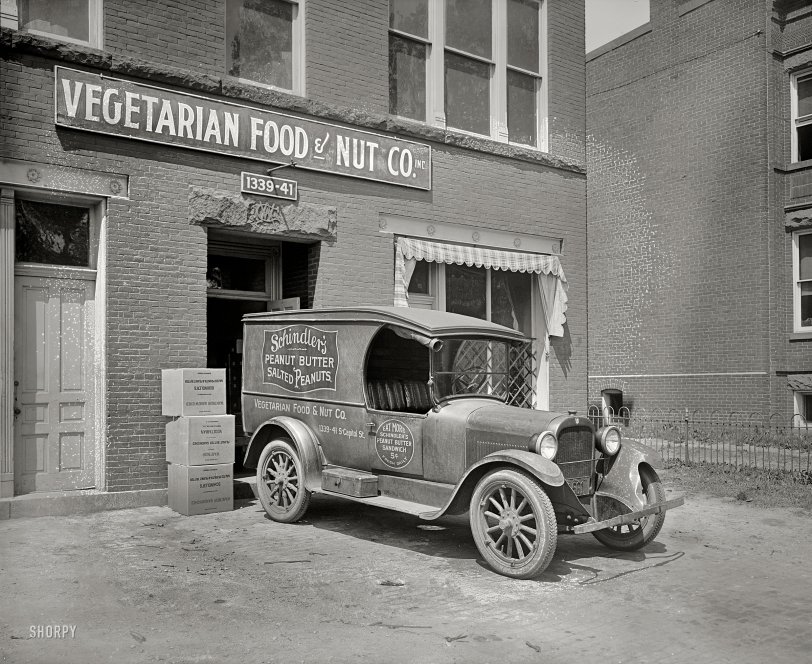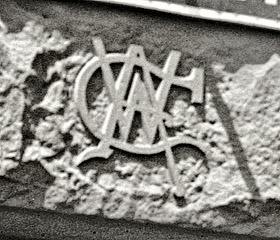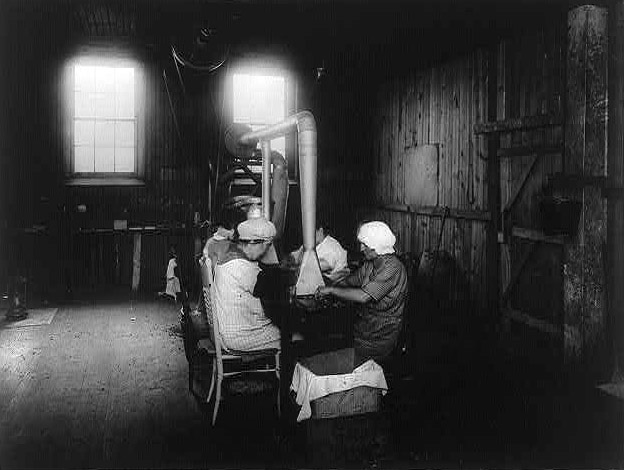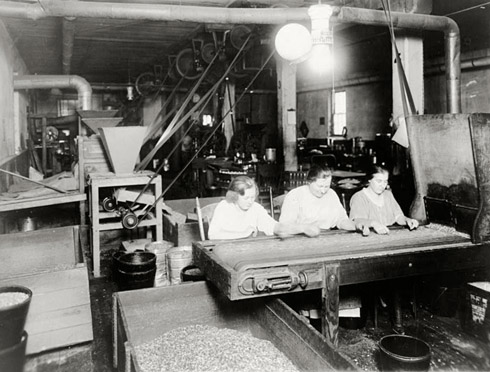


Framed or unframed, desk size to sofa size, printed by us in Arizona and Alabama since 2007. Explore now.
Shorpy is funded by you. Patreon contributors get an ad-free experience.
Learn more.

- Texas Flyer wanted
- Just a Year Too Soon
- WWII -- Replacing men with women at the railroad crossing.
- Yes, Icing
- You kids drive me nuts!
- NOT An Easy Job
- I wonder
- Just add window boxes
- Icing Platform?
- Indiana Harbor Belt abides
- Freezing haze
- Corrections (for those who care)
- C&NW at Nelson
- Fallen Flags
- A dangerous job made worse
- Water Stop
- Passenger trains have right of way over freights?
- Coal
- Never ceases to amaze me.
- Still chuggin' (in model form)
- Great shot
- Westerly Breeze
- For the men, a trapeze
- Tickled
- Sense of loneliness ...
- 2 cents
- Charm City
- What an Outrage
- Brighton Park
- Catenary Supports
Print Emporium
Vegetarian Nut: 1926

Washington, D.C., 1926. "Semmes Motor Co. -- Schindler's truck." From an interesting if moldy series of pictures showing Washington delivery trucks in their natural habitat of side streets and back alleys. Note the different varieties of "Wantmor" peanut butter sandwiches. National Photo Co. View full size.
RE: detail
I saw this logo on a truck yesterday and realized I had seen it here. I think this building must have been part of Central Armature Works.
Nutty Business
Washington Post, Jun 14, 1913Stock Issue Authorized
The Vegetarian Food and Nut Company was incorporated yesterday, with a capital stock of $45,000, divided into 2,250 shares of the par value of $20 each.
The concern, the plant of which is located at 1307-15 South Capitol street, will acquire the business that has been conducted by Mrs. Belle Coleman, and continue the manufacture of vegetarian food products. Mrs. Coleman, W.H. Coleman, Miss F.M. Coleman, 1804 Riggs street northwest; J.H. Bilbrey, 1207 N street northwest, and A.L. Bowen, 742 Newton place northwest, will constitute the board of five directors that will manage the business the first year.
Advertisement, Washington Post, Jul 16, 1914Vegetarian Food and Nut Company
W.H. Coleman, President,
Largest Exclusive Manufacturers ofPeanut Oil Products in America
General Offices and Factory,
South Capitol and N Streets
Conceded by Food Experts the Finest Made.
Sold by Nearly 2,000 Washington Grocers.Specialties: Dr. Schindler's Peanut Oil Butter, Pure Sugar Syrup (maple flavor). Salted Peanuts.
Cable Address: Vegetarian, Washington, Long Distance, Phone Lincoln 2112.
Washington Post, Aug 14, 1921Peanut Business Sold
The plant of the Vegetarian Food and Nut Company, manufacturers of Dr. Schindler's peanut butter, has been sold to Harry Rose, S. Sherry Stein and Louis Becker, who will continue to operate the plant. In addition to manufacturing peanut butter, salted peanuts are among the other products of the firm, which operates from a three-story plant located on South Capitol and M streets southwest.
Washington Post, Mar 12, 1933Old Athletic Club, Now Plant, Burns
Peanut Butter Factory Fire Rages Next to 15,000 Gallons of Gasoline.
Having withstood the grunts and groans of wrestlers when it was the Business Men's Athletic Club more that 40 years ago and many years of use as Schindler's Peanut Butter Factory, one of the old Washington landmarks, at 1339 South Capitol street, succumbed to flames yesterday which seriously injured two firemen and endangered the whole neighborhood by their proximity to 15,000 gallons of gasoline.
…
The fire was said to have been started by a peanut cooker which was found in operation. Gas flames under it were thought to have boiled the peanut oil over the cooker and started the blaze.
Washington Post, Oct 21, 1956Peanuts Hold High Rank with T. Earle Bourne
Schindler Concern Handles 4 Million Pounds a Year.
T. Earle Bourne is one man who won't complain if you tell him his business is peanuts. He feels it's "the nuts" in a big way — almost four million pounds of nuts a year, in fact.
Bourne is president of Schindler's Peanut Products, Inc. and has been since he roasted his first peanut in a commercial way in 1924.
The great Negro scientist George Washington Carver, proved that man could make more than 200 products out of peanuts, but Bourne is content to make just one thing — money. Schindler's does more than $1 million worth of business a year, which every will agree isn't … well, but it is.
Schindler's was started around 1900 by a Washington doctor name Schindler who called the business the Vegetarian Food and Nut Co. It had an extremely practical purpose in those days. The good doctor manufactured raw peanut butter which he ladled out in large doses to constipated patients with excellent results.
Bourne took over in 1924 when the owner, William S. Coleman, died. Bourne had been working with his father, James F. Bourne, in a Baltimore food brokerage business and also was fresh from a job with the Pet Milk Co. in Pittsburgh. The business then was located at 1339-41 South Capitol st., in the old southeast Athletic Club building. Bourne kept it there until 1941 when he bought land at 18th and Bryan sts. ne. He wanted to build there but wartime difficulties changed his mind and he decided to buy a ready-made building. He could find nothing to suit his wants in Washington so he bought a building at 500-26 S. Fulton ave. in Baltimore. There the peanut plant has remained. However, Bourne has always maintained his business headquarters in Greater Washington and moved into his present offices at 3711 Rhode Island ave., Mt. Rainer, in 1954.
New equipment was purchased for the Baltimore plant during and after World War II and an addition to the plant was constructed in 1944. The expansion decreased the warehouse space, so Bourne stores his peanuts in Suffolk, Va.
Schindler's buys peanuts from shelling and cleaning plants located near the peanut farms in Florida, Alabama, Georgia, South Carolina, North Carolina and Virginia. These nuts, plus cashews, filberts, almonds, pecans, Brazil nuts, English walnuts and black nuts come flooding in to the plant in Baltimore and go out as salted peanuts, peanut butter and peanut butter sandwiches (in cracker form). Most of the nuts, except peanuts, come from abroad through wholesale dealers and importers. Filberts, for example, come mostly from Turkey.
The nuts are sold to vending machine operators, chain grocery and drug stores and other retail outlets in bags, vacuum tins, and in 30-pound bulk boxes. Schindler's market includes 10 states on the Eastern Seaboard, Puerto Rico, Bermuda and the Panama Canal area.
Bourne also sells raw nuts to candy makers and does a thriving by-product business by dispensing the peanut hearts to wholesale feed dealers for wild bird food and to oil mills for peanut oil, a high quality vegetable oil. Farmers buy peanut skins for stock feed.
The 59-year-old Bourne didn't think much about peanuts after graduating from Baltimore Polytechnic Institute in 1915. He went to work selling beds and then enlisted in the Navy in 1917. He emerged in 1919 as an ensign and went to work for his father.
[Notes: In 1921, Dr. Schindler's Peanut Butter sold for 21 cents a pound. Schindler's stopped manufacturing peanut butter about 1968.]
Animal Writes
It's always interesting to see that the idea of a meatless diet is hardly a recent trend. Even the term Vegan goes back well into the 1940s.
[Writes with ... a pig pen? - Dave]
Perhaps a quill feather pen, this lettering looks pretty fancy.
Man, that was good p-butter!
Schindler's Nut Co. expired in the 1990s, I think. They supplied peanuts to the Baltimore baseball parks for many years.
But I remember them for their peanut butter. In the '50s, the only place that sold it was the mom-and-pop neighborhood groceries, no chains (at least none my mom shopped in).
I swear, you could lay block with that stuff, but I have never found any p.b. anywhere that tastes as good. About 20 years back, I got to wondering if they still made it, and called their office in Baltimore. The lady who answered the phone told me, "Sir, I've worked here for twenty-five years, and we haven't made peanut butter since I've been here." Yeah, and it wasn't delivered in a rig like this one, either.
Detail
The stone lintel over the entryway. The initials are a nice touch. I wonder whose?
[WAC = Washington Athletic Club. - Dave]

Lintels
Please note the different lintels in the brick openings. The cut-stone lintel in the center is undoubtedly part of the original brick wall. As other openings (right and left) were needed, brick was cut away and I-beams, iron or steel, were used: not of the same character as the cut-stone.
Nuts to you!
Inside:
Thanks, Dave!
BTW, In 1937, Ardil, peanut fibre, was created as I understand by separating the white inner layer from the shell and creating the fibre. Somewhere, I have a sample which my mother got, probably in 1946 when a plant was built in Dumfries, my mother's home town by Imperial Chemical Industries. I can recall it being a slightly yellowish white. It is now brownish and somewhat brittle.. Ardil production ceased in 1957.


























On Shorpy:
Today’s Top 5